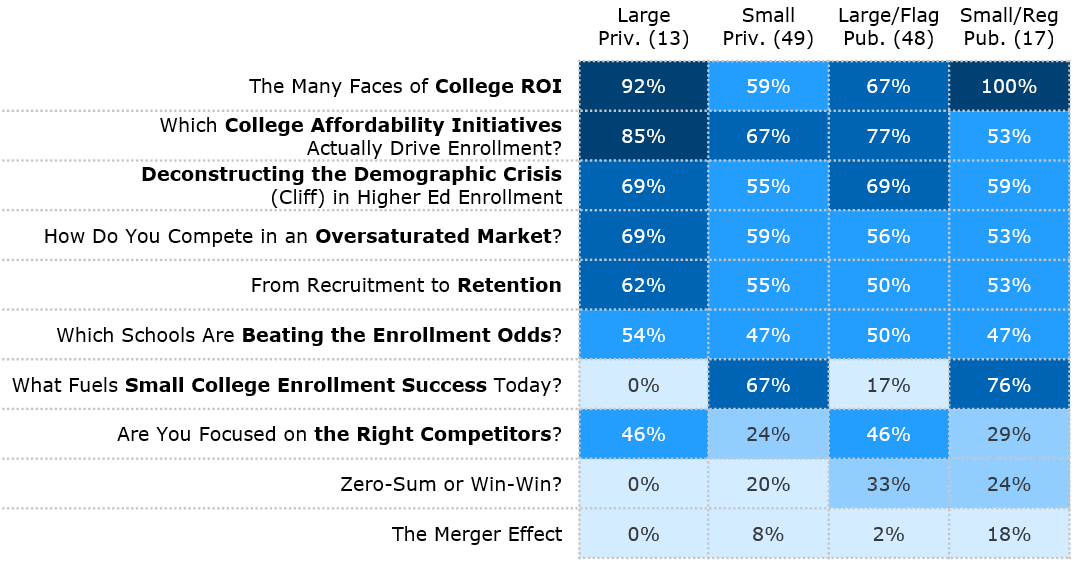5 insights from EAB’s latest enrollment research topic poll
Enrollment priorities change quickly. Demographic shifts, changing federal policies, and competitive pressures can alter what’s top of mind for enrollment leaders in a matter of months, and 2025 has been especially volatile. That’s why EAB polls enrollment leaders throughout the year to stay attuned to their most pressing concerns.
We recently surveyed 120+ public and private institutions of all sizes, asking them to choose the five research topics most relevant to their biggest challenges. The results reveal both shared concerns and important differences across institution types.
Watch Our Recent Webinar Sharing Insight into the Full List of Priorities
The top-ranked topics—and why they’re resonating now
Out of the ten topics we tested, five rose to the top. Here’s why I think these particular topics are on enrollment leaders’ minds right now.
1. The Many Faces of College ROI: How to Communicate Value Differentially by Academic Program and Audience (selected by 71% of respondents)
Why it matters now: Public skepticism about higher ed’s value has grown, with students and their families increasingly weighing career outcomes, cost, and life-readiness. Legislative scrutiny and changes to school classifications and rankings have amplified the ROI conversation, especially for programs with unclear job market alignment. New federal accountability rules that will eliminate loans for programs whose graduates don’t out‑earn peers with only a high school diploma is sure to exacerbate this further.
2. Which College Affordability Initiatives Actually Drive Enrollment? Examining the Impact of Tuition Resets, Financial Aid Innovations, Transparency Measures, Value Messaging, and More (selected by 71% of respondents)
Why it matters now: With tuition discount rates at record highs, leaders are seeking clarity on which levers (e.g., tuition resets, innovative aid models, or transparent net price tools) actually shift enrollment behavior.
3. Beyond the Hype: Deconstructing the Demographic Crisis Census Data Insights on the Real Impact of Demographic Shifts on College Enrollment Trends (selected by 62% of respondents)
Why it matters now: WICHE projects a steady, nationwide decline in high school graduates starting this year. While the “enrollment cliff” looms large in headlines, census data reveals pockets of resilience. Leaders are asking: Which markets still have growth potential—and why?
Watch EAB’s College Search Trends Webinar to Explore These Results in Region-Specific Detail
4. How Do You Compete in an Oversaturated Market? Using Institutional Personas to Identify What Sets You Apart and Where You Can Grow Recruitment (selected by 58% of respondents)
Why it matters now: With more institutions vying for fewer students, differentiation is no longer optional. The challenge is identifying traits that truly set an institution apart and backing them up with proof.
5. From Recruitment to Retention Strategies for Improving Student Success Through Better Prospect Identification and Post-Enrollment Support (selected by 54% of respondents)
Why it matters now: With each student sending more applications (i.e., 8+ per student), the cost of recruiting a student isn’t going down on its own. That’s why leaders are looking at how they can fill their funnel with more high-intent prospects, and then how they can provide targeted post-enrollment support to improve student success and stabilize overall enrollment.
Affordability is critical across the board, while segments differ on other topics
One of the striking findings from this poll is the level of overall agreement between school segments. In every segment, either ROI or affordability initiatives landed in the top slot, often joined by one or more of the other leading topics above. That’s a clear signal that leaders across the board are focused on how to make the value of higher education more compelling to prospective students, which every stakeholder involved in the college search process cares about right now (students, parents/guardians, lawmakers, and more).
Beyond that common ground, differences emerge that make sense given each segment’s circumstances. Here is a view of the data segmented by size and private/public state:

As you can see, there are significant differences in the interests of certain segments compared to others. For example:
- Large private schools placed especially high importance on ROI and market differentiation, reflecting both their competitive peer sets and their ability to directly shape messaging and pricing strategies. For these institutions, fine-tuning the value narrative and standing out in a crowded market are essential to maintaining their national draw.
- Small/regional public schools understandably showed high interest in small college success factors, which is indicative of a desire for strategic recommendations in a segment facing more headwinds. Many of these institutions are contending with shrinking local markets, making insights into resilience and growth strategies particularly urgent.
- Public and private institutions diverged somewhat on affordability initiatives, with publics showing lower relative interest. This is understandable given the fact that public institutions have less control over tuition-setting and related policies than their private peers. For many publics, state-level funding formulas and political constraints shape affordability far more than institutional decision-making, shifting their focus toward other areas where they have greater influence.
These differences don’t suggest fundamentally different priorities so much as different institutional contexts and constraints. The broad alignment on core topics such as value, affordability, and differentiation remains striking.
Looking ahead
Several of our research projects this year will dive deeper into the top concerns revealed here, ensuring we’re not just listening but actively responding to what enrollment leaders tell us they need most. Stay subscribed to our blog to receive updates as our research progresses.
If you’re interested in a deeper dive into these topics, please watch our video breaking down the survey results or connect with an EAB expert to discuss how we can assist with your institution’s enrollment efforts.

More Blogs

What enrollment leaders can learn from Alabama’s statewide direct admissions program

4 questions domestic students will ask before applying to your graduate program
